Posted on November 5, 2015
Mission San Juan Capistrano and the messages in the walls
On Sunday, November 1st, we reached San Juan Capistrano, navigating past a dizzying array of mission-themed tourist shops. “First there was Mission San Juan Capistrano,” an Acjachemen friend wryly remarked to us. “Then, there was Disneyland.”
In front of the mission, we were embraced by a warm welcome from Acjachemen women leaders, and many others who had come to join with us for a time of truth telling and healing. Although the circumstances of our coming together were not happy ones, by the time we left the mission, we felt truly uplifted and inspired.
With Acjachemen spiritual leader Adelia Sandoval and storyteller Jacque Tahuka-Nuñez in the lead, 50 people walked onto the mission grounds, forming a large circle amidst the ruins of the old stone cruciform church. Adelia blessed everyone in the circle with purifying sage, and opened the circle with a prayer to the ancestors, asking for them to be with us. She turned and gestured to the stone wall behind her.
“Our ancestors put these rocks together with their own hands. The reason why I like standing right here, is because this wall has our Acjachemen medicine in it. As our ancestors were building the wall, they placed in it these shells, and crystals, and obsidian—their own medicine. Today, we can touch these walls, we can feel these shells, and know that our ancestors touched them too. It is a precious gift that they gave us.”
Adelia continued, welcoming people in the Acjachemen language and thanking everyone for their presence. “Today is a very spiritual time, because we’re here with our sister from the north of us: Caroline and her son Kagen, who had a moment of inspiration from the divine, from the great spirit, to do something that meant something very powerful. And as California Mission Indians, sometimes we feel very powerless. We feel like we don’t have any voice, or we don’t have any strength. But Caroline felt something come from within her, and said, I’m going to do something. I’m going to take action.”
Adelia introduced walk leader Caroline Ward Holland, who shared stories from the over 600 miles that she has walked so far. Throughout the journey, Caroline explained, she has felt acknowledged and guided by the ancestors. “I firmly believe that since the beginning of time, we get messages from our ancestors and from our elders. And my whole life, I’ve been waiting to grasp those messages and to do this walk.”
Caroline related some of the deeply disturbing stories that have been shared by other indigenous people, at each mission. “There’s no excuses for what happened to our people at these missions. Excuses are worse than lies. It’s very disheartening to think that they still won’t even acknowledge what happened— especially with the missions being tourist attractions today. They’re not that, for us.”
“We are human beings,” Caroline said. “We bleed, we have jobs, and brothers and sisters and daughters. Their Doctrine of Discovery still says that we are not, that they were the first human beings here in this area. Now, our villages are their prime real estate. And we have nothing.”
Acjachemen educator and singer Jacque Tahuka-Nuñez described the terrible racial discrimination that her mother experienced, growing up in San Juan Capistrano. “I come here today because of my mother. Because my mother was taken from San Juan Capistrano—she was taken to the [Catholic] boarding school in Banning.”
“Though I am an educator, and I always walk in the world seeking a way to build a bridge, that historical trauma still haunts me. My mother did not raise me and my brother and my sister with kindness. She didn’t know how. I longed for my mother to touch my face and say, I love you, sweetheart. But she didn’t know how. And when I was 17, it was the first time I ever saw my mother cry. And she began to speak of her experiences.”
“Was I for canonization? No.” Jacque exclaimed. “Did I want to say horrible things? No, that’s not my nature. But I knew this: I wanted the Diocese to come to each one of us and say: What your people experienced wasn’t OK. And it wasn’t right. And we ask, by God, looking at all of us, we’re sorry that that happened. And we will promise it will never happen again. I wanted to hear those words. But no one came.”
“We just want our story to be told,” Jacque said. “We want you to acknowledge our story full of pain. And, know that there should be something done. We are California Indians that have nothing, unless we’re a casino tribe, and we’re not. So, all we have is the beauty of what God gave us. [In facing these things,] I ask that all of us lead our lives in a way that when we take a step, it is a step of healing, and not hurting.”
“We’re not asking for anything that doesn’t belong to us,” Caroline Ward Holland added. “This ground right here, this whole place was built by the indigenous people. All we’re asking for is to be able to have something back that’s ours.”
Adelia Sandoval stepped forward to introduce a traditional Acjachemen song. “It’s a time of the harvest, so we’re going to sing our harvest song for you, as a gift. And also, it’s medicine. In the spring time we plant seeds of prayers, and now, in this time we harvest what we planted.” The shell of the earthquake-stricken, ruined stone church rang with womens voices in harmony, singing out in their ancestral language, elderberry clapper-sticks gently keeping time.
After another song, Adelia and Jacque led the group across the mission grounds to the old cemetery, where thousands of indigenous people are buried in unmarked graves. Caroline Ward Holland and Kagen Holland led a Tataviam tobacco blessing, and space was opened for more stories to be shared.
Charles Sepulveda, a scholar of Acjachemen and Tongva descent, thanked the walkers for the journey they’ve undertaken. “I just wanted to share some brief history about why being here, today, is so significant,” Charles said. He explained that Mission San Juan Capistrano was first founded in 1775. “But they had a little problem. Mission San Diego was sacked a couple days after the founding. [Indigenous people] burned down the mission, and killed the priest, Father Jayme. It was a ceremonial killing.” Fearing their tenuous grip on California could be lost, the missionaries buried the San Juan Capistrano mission bells in the ground and fled with an escort of soldiers back to the San Diego Presidio in an effort to re-assert control.
One year later, Junipero Serra returned with a contingent of soldiers to unbury the bells and re-found San Juan Capistrano mission on November 1st (the same calendar day as our gathering.) “I’ve been reading Junipero Serra’s writings from that time,” Charles said. “He was saddened by the fact that they had to leave San Juan Capistrano. Then two years later in 1778, he writes about the Acjachemen rising up, and conspiring to burn down the mission.”
“So, we’ve had a long tradition of resisting the mission. Resisting the canonization of Serra is just another part of that. We haven’t stopped resisting. Even if we’ve become Catholic, even if we go to church. we’re still resisting the effects that it had on our ancestors. What we’re doing here is also part of that resistance—we’re spreading these knowledges, these truths, and talking about how we can heal from this, how we can move forward. How can we prevent what has happened to us in the past from happening again to our future generations?”
Jacque Nuñez held up a small, beautiful basket, and smiled. “While we’re talking, I want to pass around this basket was made by my mother’s hands. I want your hands to touch it. There’s tobacco and sage in it, please take some of that. It’s my way of letting you take a little piece of today. Take it home, and find a little place for it. It’s a little gift, and your hand touching this is a gift to me. Thank you.”
Corine Fairbanks of the Southern California American Indian Movement shared some reflections and words of encouragement. “One of the things that my relatives have told me, is that when you step out, and you do this kind of work, you’re attacked in so many different ways. When you take a step forward, you make people angry. Because people don’t want to think about the bad things that happened, even though that’s part of the healing journey.”
“Remember that some day we’re all going to be ancestors, too,” Corine offered. “And our ancestors prayed for us to be here. And so, you’re walking prayers. We’re walking prayers. And you know what, I hope my children will be walking prayers for what’s going to come next. And I thank all of you for taking the time to be here, where you could have been doing something else.”
“I want everybody to get close and gather around Caroline and her sons,” Jacque said. She explained that an Acjachemen elder recently passed away, who “used to lead many ceremonies like this one.”
“He said that our people need to come together, and we need to touch one another.” Jacque instructed everyone to gather close and place their hands on one another’s shoulders, as a traditional healing song was sung in call and response. The song began softly, and rose in volume as everyone began singing in unison.
“We are not done here, in a lot of ways,” Adelia Sandoval said in closing. “And perhaps, for some of us, this is a beginning. A beginning of really looking inside, and seeing what’s really going on. And what is it that we can do next? Because there is always something that we can do next. We can be inspired, and we can continue on. But don’t let it fall to the ground and do nothing with this day. Do something with this day. Especially, teach your children. Because that is the most important thing, for they are our future. Let us all go out and speak words of strength and healing. Let’s all go forth with loving action. And whatever comes from this time together that we have had, may it be multiplied a thousand-fold.”



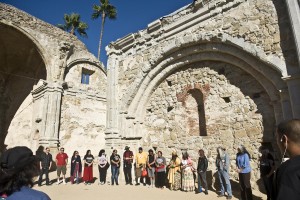
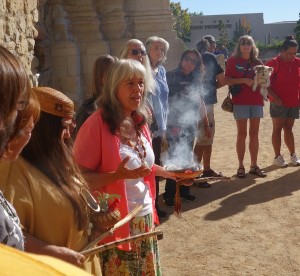
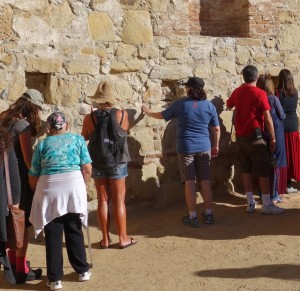
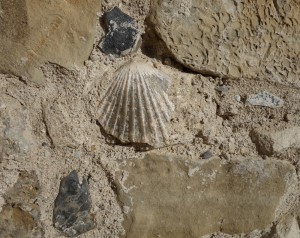
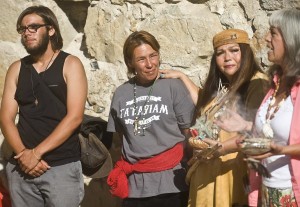
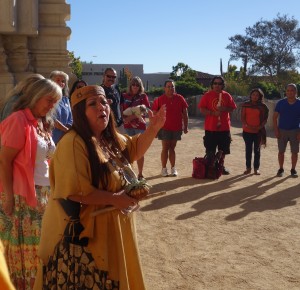

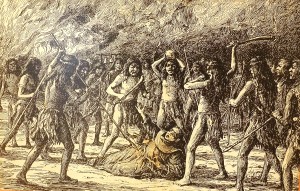
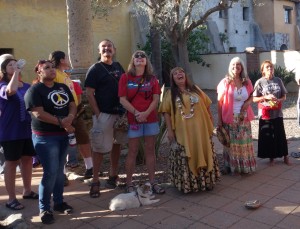
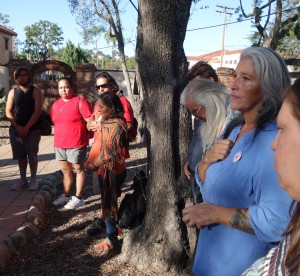
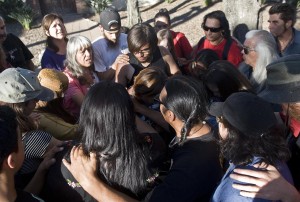
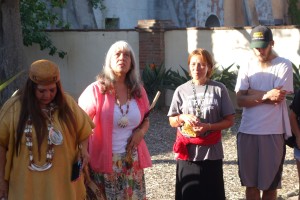
Thank you for all of the important and wonderful information.